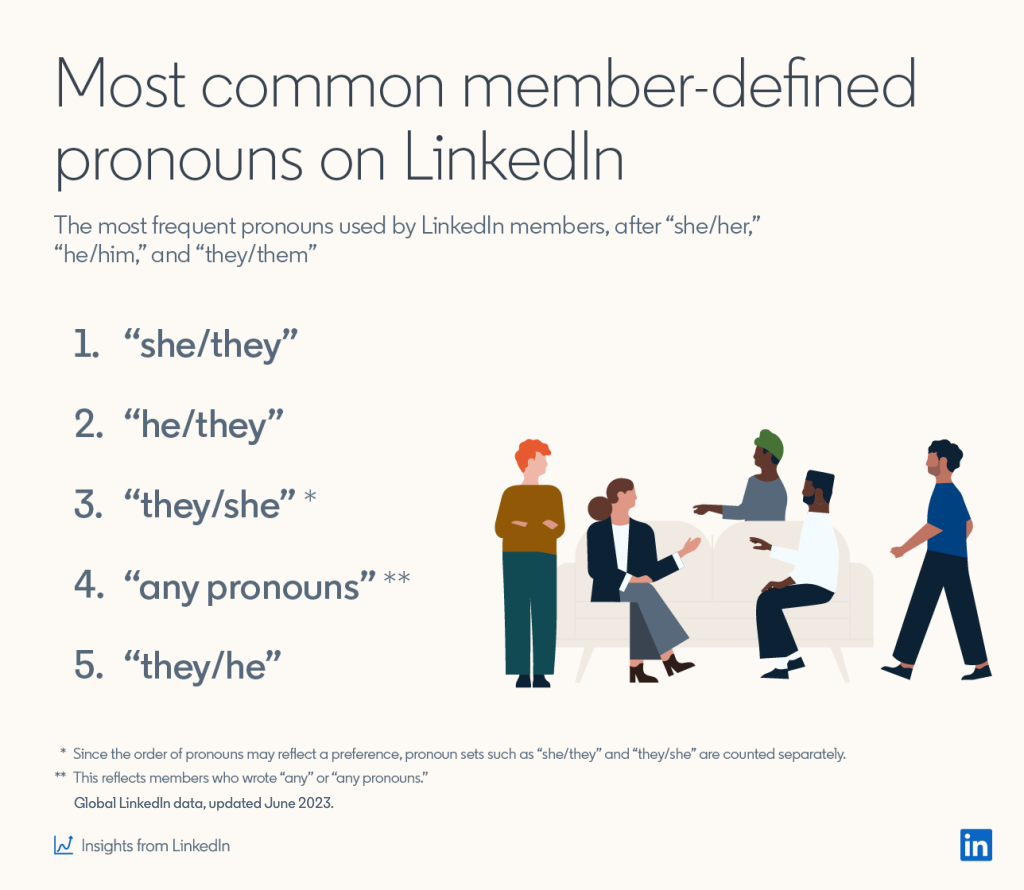Pronouns: An Introductory Resource
What are pronouns?
Pronouns are words that you use in place of a noun, like someone’s name.
Instead of always having to use people’s names, we often use pronouns in their place.
“James is over there. Let’s go say hi to
James
him!”
Gendered pronouns associate a gender with the person you’re referring to, whilst gender-neutral pronouns do not.
| Gendered pronouns |
Gender-neutral pronouns |
| "He was ecstatic with his feedback!" "When it was her turn she aced it!" |
"I think they found their calling in life!" |
Want to know more about the history of singular 'they'?
Read this article from the Oxford English Dictionary.Link opens in a new window
Want to know more about the evolution of singular 'they' as a gender-neutral pronoun?
Read this Merriam-Webster article.Link opens in a new window
How do you know what pronouns to use?
You can’t tell someone’s gender, or their pronouns, from the way they look.
It’s important that we learn not to assume gender and gendered pronouns.
“I use he/him pronouns”
“I use she/her pronouns”
“I use they/them pronouns”
It’s OK to ask what pronouns someone uses.
“Hi Morgan! What pronouns would you like me to use for you?’
If you’re not able to ask, you can use ‘they/them’ pronouns as a gender-neutral default.
How do you share your pronouns?
Sharing your pronouns opens the door for others to share theirs…
“Hi, I’m Amoya and I use she/her pronouns!”
“Hi, I’m Nayan and I use they/them pronouns!”
...and helps to break down the belief that you can assume people’s gender/pronouns.
You can:
- wear a pronoun badge (find out where to get a free badge here),
- add your pronouns to your email signature (in line with the University's brand guidance hereLink opens in a new window) and Microsoft profile (using the guidance here), and
- introduce yourself to new people including your pronouns.
“Hi everyone, shall we introduce ourselves? I’m Artur and I use he/him pronouns”
"I’ve added my pronouns to my email signature a while ago now, around the same time as I started to invite participants of meetings I chair, to introduce themselves with the addition of their pronouns if they so wish. I tend to do it myself too. It’s been well received, as it is just a bit of etiquette to make sure everyone is addressed as they would like to."
Professor Gwen van der Velden
Deputy Pro Vice Chancellor (Education)
You can pick up a free pronoun badge from the seating area opposite Senate House Reception:

Why are pronouns important?
Gender can be very important to someone’s sense of self.
Using the incorrect gender for someone can make them feel upset, embarrassed, misunderstood, and/or dysphoric.
(Dysphoria is the profound sense of discomfort people may feel at their gender being perceived wrongly.)
If you make a mistake with someone’s pronouns, you should briefly correct yourself and move on.
“Kay said that he… sorry, she…
would like to be involved with the new project”
If someone else uses the wrong pronouns, you can correct them too.
“I think Jay uses ‘they’ pronouns rather than ‘he’...”
“Actually, Sarah uses ‘she’ pronouns.”
What pronouns are there?
You will be familiar with at least three sets of pronouns:
| She/her |
She believes me |
I spoke to her |
Her hand reached out |
The gift is hers |
She thinks to herself |
| He/him |
He believes me |
I spoke to him |
His hand reached out |
The gift is his |
He thinks to himself |
| They/them |
They believe me |
I spoke to them |
Their hand reached out |
The gift is theirs |
They think to themself |
‘They’ is grammatically correct for both a single person, and a group of people.
If you find it confusing, imagine you’ve arrived at a cafe to find someone has left a wallet on the table. You would take it to the staff counter and say...
“Someone left their wallet on the table.”
“They might need it soon.”
“Could you try to contact them?”
It’s as simple as that to use singular ‘they’ pronouns for someone.
Some people use a mixture of pronoun sets, such as 'she' and 'they, or 'he' and 'they' (usually communicated in writing as she/they or he/they pronouns).
Other less commonly used pronoun sets include:
| Ey/em* |
Ey believe me |
I spoke to em |
Eir hand reached out |
The gift is eirs |
Ey think to emself |
| Ze/zir** |
Ze believes me |
I spoke to zir |
Zir hand reached out |
The gift is zirs |
Ze thinks to zirself |
| Ze/hir** |
Ze believes me |
I spoke to hir |
Hir hand reached out |
The gift is hirs |
Ze thinks to hirself |
*This is the same as ‘they/them’ pronouns if you remove the ‘th’!
**These pronouns are similar to a combination of ‘he’ and ‘her’ pronouns, which can help you to remember them.
Practice using different sets of pronouns online with 'Practice with Pronouns'Link opens in a new window.
This project is part of the Queering University programme, which offers a wide variety of further resources, events, initiatives and support.
Resources
Try using different sets of pronouns online with 'Practice with Pronouns'.
Collect a free pronoun badge.
Update your email signature to include your pronouns in line with the University's brand guidance.
Update your Microsoft profile to include your pronouns.
Read this guide to challenging incorrect pronouns and misgendering.
This project is part of the Queering University programme, which offers a wide variety of further resources, events, initiatives and support.

